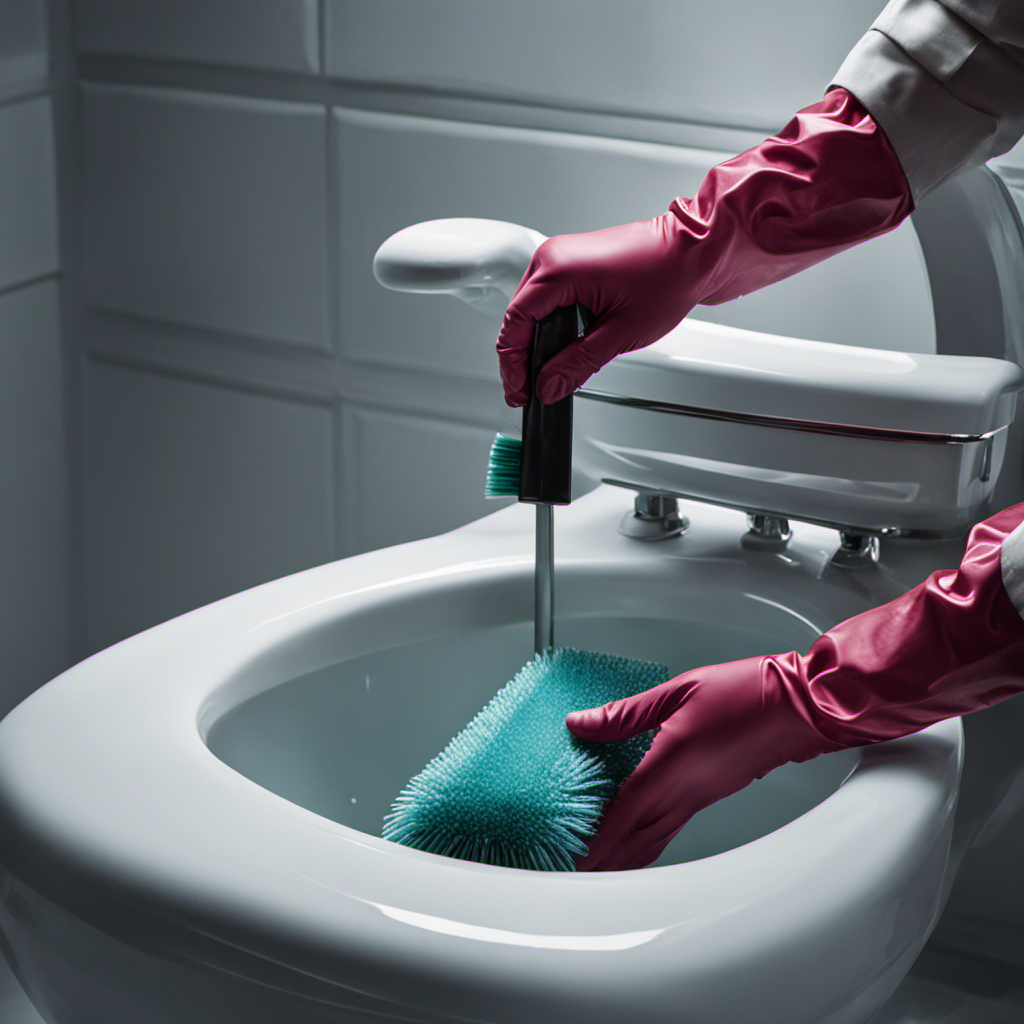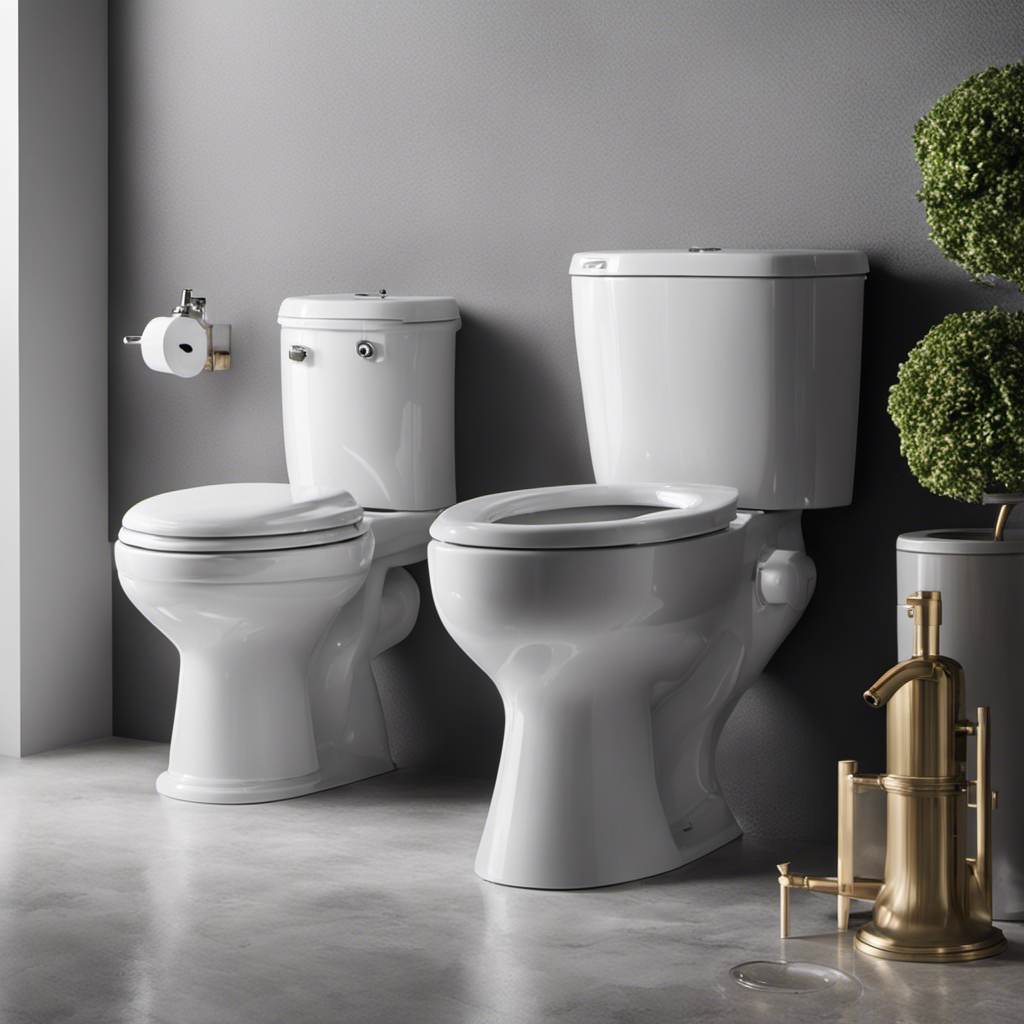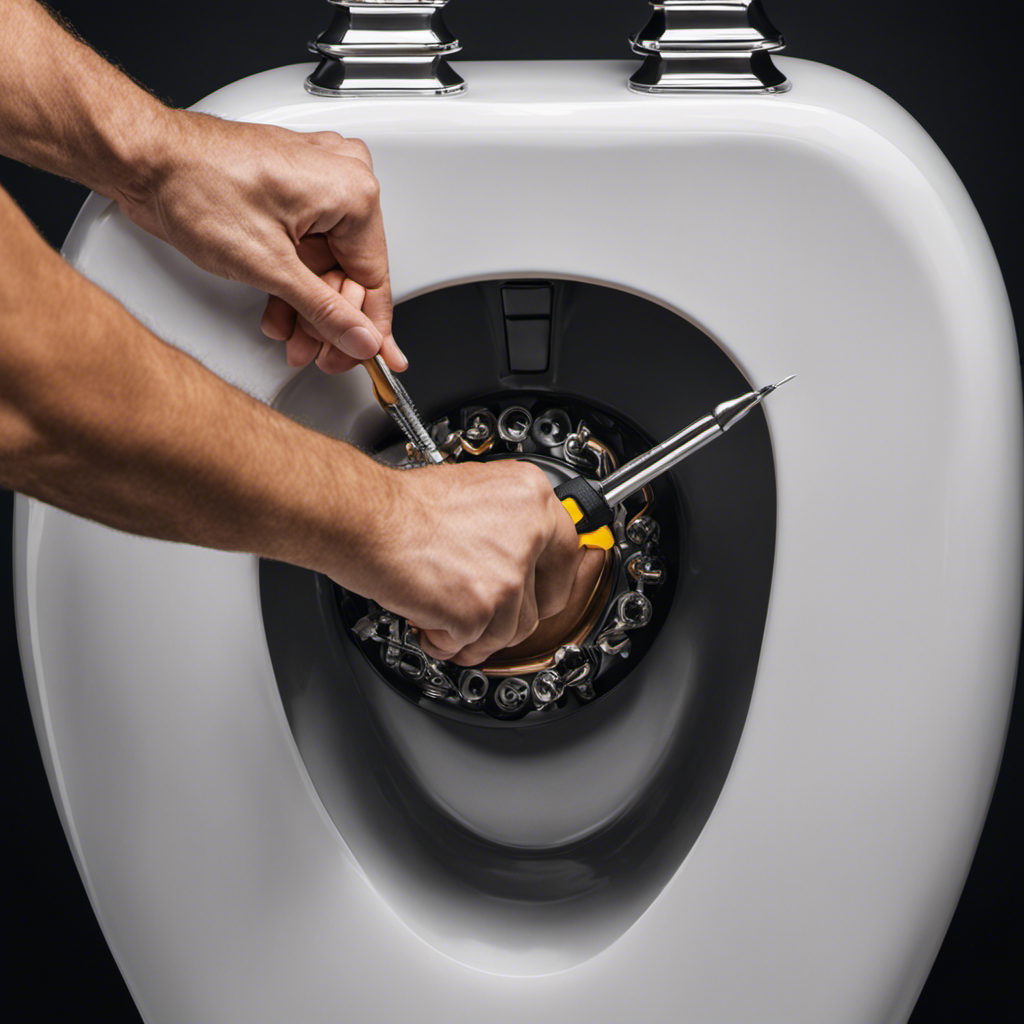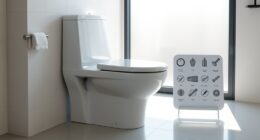I’ll show you how to clean a toilet tank in just a few simple steps.
You may not think about it often, but maintaining a clean toilet tank is essential for a hygienic bathroom.
By following this guide, you’ll be able to keep your toilet tank sparkling clean and free from any unwanted odors.
With just a few supplies and a little bit of time, you’ll have a clean and fresh toilet tank that will last for years to come.
Key Takeaways
- Regular cleaning prevents foul odors, discoloration of water, and growth of harmful bacteria.
- Neglecting to clean the tank can result in the spread of bacteria and germs.
- Cleaning the tank is crucial for maintaining proper sanitation in the bathroom.
- Prioritizing tank cleaning as part of a regular cleaning routine is essential.
Understanding the Importance of Cleaning the Toilet Tank
Understanding the importance of cleaning the toilet tank is crucial for maintaining proper sanitation. Regular cleaning of the toilet tank offers numerous benefits and helps prevent potential health risks.
Over time, mineral deposits, mold, bacteria, and other contaminants can accumulate in the tank. These build-ups can lead to foul odors, discoloration of the water, and even the growth of harmful bacteria. By cleaning the tank regularly, you can eliminate these issues and ensure a clean and hygienic toilet.
Neglecting to clean the toilet tank can result in the spread of bacteria and germs, leading to potential health problems for you and your family. Therefore, it is essential to prioritize cleaning the tank as part of your regular cleaning routine.
Now, let’s move on to the next step of gathering the necessary supplies and equipment.
Gathering the Necessary Supplies and Equipment
To get started, you’ll need to gather all the supplies and equipment necessary for the task at hand. Here are the three items you’ll need for effective toilet tank maintenance:
-
Cleaning solution: Choose a toilet tank cleaner specifically designed to remove mineral deposits, mold, and bacteria. Look for a cleaner that is safe for use on all toilet components.
-
Scrub brush: A sturdy scrub brush with bristles is essential for scrubbing away stubborn stains and buildup inside the toilet tank. Make sure the brush has a long handle to reach all areas of the tank.
-
Rubber gloves: Protect your hands from the cleaning solution and any potential bacteria by wearing rubber gloves. Opt for gloves that are thick and waterproof for maximum protection.
Now that you have everything you need, it’s time to move on to draining the toilet tank and removing any remaining water.
Draining the Toilet Tank
Once you’ve gathered all the necessary supplies and equipment, it’s time to start draining the toilet tank. This step is crucial for proper toilet tank maintenance and should be done regularly to ensure optimal performance. Follow these simple steps to drain your toilet tank effectively:
-
Turn off the water supply: Locate the shut-off valve, usually located behind the toilet, and turn it clockwise to stop the water flow.
-
Flush the toilet: Flush the toilet once to remove most of the water from the tank.
-
Use a sponge or towel: Soak up any remaining water in the tank using a sponge or towel. Squeeze out the water into a bucket or sink.
-
Empty the bucket: Once the water is drained, empty the bucket into a sink or toilet.
Following these best practices for draining your toilet tank will help maintain its cleanliness and functionality.
Regular maintenance is key to preventing any potential issues down the line.
Scrubbing and Disinfecting the Inside of the Tank
Make sure you scrub and disinfect the inside of your toilet tank regularly to maintain cleanliness and prevent any potential issues. Here’s a step-by-step guide on how to properly clean and sanitize your toilet tank:
-
Gather your supplies:
- Sanitizing solution: Look for a toilet bowl cleaner that is specifically designed to kill bacteria and germs.
- Cleaning brushes: Use a toilet brush with stiff bristles to scrub the inside of the tank effectively.
-
Turn off the water supply: Locate the water valve near the base of the toilet and turn it clockwise to shut off the water flow.
-
Remove the lid: Carefully lift the lid of the toilet tank and set it aside on a clean surface.
-
Scrub the tank: Dip the cleaning brush into the sanitizing solution and scrub the inside walls of the tank, paying special attention to any stained areas or mineral deposits.
-
Rinse and flush: After scrubbing, rinse the tank thoroughly with clean water. Then, flush the toilet a few times to ensure all the cleaning solution is flushed out.
Cleaning the Exterior of the Toilet Tank
When it comes to cleaning the exterior of the toilet tank, there are a few key points to keep in mind.
First, it is important to consider the tank material compatibility. Different materials may require different cleaning methods and products to avoid damage.
Secondly, choosing effective cleaning products is crucial for achieving a thorough and hygienic clean. Look for products specifically designed for toilet tanks and follow the instructions carefully.
Lastly, to prevent future grime build-up, regular maintenance is essential. This includes regularly wiping down the exterior of the tank and using preventive measures such as installing a tank lever lock to keep the tank lid closed when not in use.
Tank Material Compatibility
To ensure you don’t damage the tank, be mindful of the material compatibility when choosing cleaning products. Not all cleaning products are suitable for all types of toilet tank materials. Here are three key factors to consider:
-
Porcelain tanks: Porcelain is the most common material used for toilet tanks. It is durable and resistant to most cleaning products. However, avoid using abrasive cleaners or scrub brushes that can scratch the surface.
-
Plastic tanks: Plastic tanks are lightweight and less prone to cracking. When cleaning, use mild soapy water or non-abrasive cleaners specifically designed for plastic surfaces. Avoid harsh chemicals that can cause discoloration or damage.
-
Metal tanks: Metal tanks, such as those made of copper or brass, require gentle cleaning to prevent corrosion. Use non-abrasive cleaners specifically formulated for metal surfaces. Avoid acidic or abrasive products that can cause tarnishing or scratching.
Understanding the material compatibility is crucial for effective toilet tank maintenance and cleaning.
Now, let’s explore the next section on effective cleaning products.
Effective Cleaning Products
Now that we know which cleaning products are safe to use on different types of toilet tank materials, let’s explore some effective options.
When it comes to cleaning products, there are plenty of safe and eco-friendly options available. One popular choice is vinegar. Its acidic properties can help break down grime and eliminate odors. Simply pour a cup of vinegar into the tank and let it sit for a few hours before scrubbing with a toilet brush and flushing.
Another option is baking soda, which can be used in combination with vinegar for added cleaning power. Sprinkle baking soda into the tank, then add vinegar and let it fizz. Scrub and flush as usual. These natural alternatives are not only effective but also better for the environment.
Transitioning into the next section, preventing future grime is essential to maintaining a clean toilet tank.
Preventing Future Grime
If you want to prevent future grime buildup, regularly adding a cleaning tablet to the water inside the tank is a simple and effective solution.
Here are three reasons why this method is beneficial for preventing future odor and reducing bacteria growth:
-
Continuous cleaning: Cleaning tablets release cleaning agents into the water every time you flush, ensuring that the tank remains clean and free from grime buildup. This helps to prevent any unpleasant odors that may arise from stagnant water or bacteria growth.
-
Effortless maintenance: By using a cleaning tablet, you can effortlessly maintain a clean toilet tank without the need for manual scrubbing or frequent deep cleaning. Simply drop a tablet into the tank and let it do the work for you.
-
Long-lasting effects: The cleaning agents in these tablets provide long-lasting effects, keeping the water in the tank clean and fresh for an extended period. This helps to reduce bacteria growth and prevent any potential odor problems.
Maintaining a Clean Toilet Tank for Long-Term Use
Regularly cleaning your toilet tank is essential for ensuring its long-term use. To maintain a clean toilet tank, there are a few key strategies you can follow.
Firstly, start by turning off the water supply to the tank. This can usually be done by turning the valve located on the wall near the base of the toilet.
Next, flush the toilet to empty the tank of any remaining water. Now, it’s time to clean. Use a mixture of bleach and water to scrub the inside of the tank, paying special attention to any areas with visible grime or stains.
After thoroughly cleaning, rinse the tank with clean water and wipe it dry. Finally, turn the water supply back on and flush the toilet to ensure everything is working properly.
Frequently Asked Questions
How Often Should I Clean My Toilet Tank?
I clean my toilet tank regularly to maintain cleanliness and prevent buildup. The best practice is to clean it every 3-6 months. To do so, follow the recommended cleaning methods for toilet tanks.
Can I Use Bleach to Clean the Inside of the Tank?
Yes, you can use bleach to clean the inside of the tank. However, I recommend using vinegar instead. It is a natural cleaner that has many benefits, such as being non-toxic and environmentally friendly.
Is It Necessary to Remove the Toilet Tank Lid Before Cleaning?
Removing the toilet tank lid before cleaning offers several benefits. It allows for easier access to the tank, ensuring a more thorough cleaning. Additionally, it allows for inspection of the tank components for any potential issues.
What Should I Do if the Water in My Toilet Tank Is Discolored?
If the water in my toilet tank is discolored, I should first identify the causes, such as rust or minerals. To prevent toilet tank discoloration, regular cleaning and using a water softener can help.
Are There Any Eco-Friendly Alternatives to Chemical Cleaners for Cleaning the Toilet Tank?
There are eco-friendly alternatives to chemical cleaners for cleaning a toilet tank. Natural toilet tank cleaners can be just as effective in removing stains and odors while being environmentally friendly.
Conclusion
After following the step-by-step process of cleaning a toilet tank, it’s clear that regular maintenance is essential for a clean and hygienic bathroom.
Neglecting to clean the tank can lead to the buildup of bacteria and mold, which can be harmful to our health.
Interestingly, a study by the National Sanitation Foundation found that toilet tanks can contain more germs than a person’s smartphone!
Therefore, taking the time to clean the tank thoroughly is crucial for a healthy and sanitized bathroom environment.










